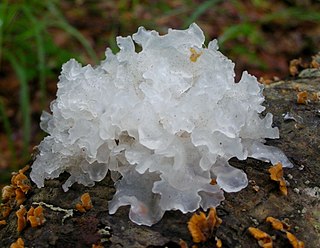
Tremella fuciformis is a species of fungus; it produces white, frond-like, gelatinous basidiocarps. It is widespread, especially in the tropics, where it can be found on the dead branches of broadleaf trees. This fungus is commercially cultivated and is one of the most popular fungi in the cuisine and medicine of China. T. fuciformis is commonly known as snow fungus, snow ear, silver ear fungus, white jelly mushroom, and white cloud ears.
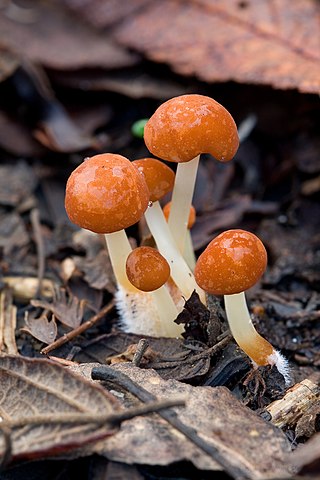
Marasmius is a genus of mushroom-forming fungi in the family Marasmiaceae. It contains about 500 species of agarics, of which a few, such as Marasmius oreades, are edible. However, most members of this genus are small, unimpressive brown mushrooms. Their humble appearance contributes to their not being readily distinguishable to non-specialists, and they are therefore seldom collected by mushroom hunters. Several of the species are known to grow in the characteristic fairy ring pattern.

Clitocybe dealbata, also known as the ivory funnel, is a small white funnel-shaped basidiomycete fungus widely found in lawns, meadows and other grassy areas in Europe and North America. Also known as the sweating mushroom, or sweat producing clitocybe, it derives these names from the symptoms of poisoning. It contains potentially deadly levels of muscarine.

Panaeolus foenisecii, commonly called the mower's mushroom, haymaker, haymaker's panaeolus, or brown hay mushroom, is a very common and widely distributed little brown mushroom often found on lawns and is not an edible mushroom. In 1963 Tyler and Smith found that this mushroom contains serotonin, 5-HTP and 5-hydroxyindoleacetic acid. In many field guides it is listed as psychoactive; however, the mushroom does not produce any hallucinogenic effects.
Marasmius semiustus is a species of fungus in the family Marasmiaceae. It is a plant pathogen responsible for banana plant disease commonly found in the West Indies. The only known remedy is the removal and burning of diseased plants.
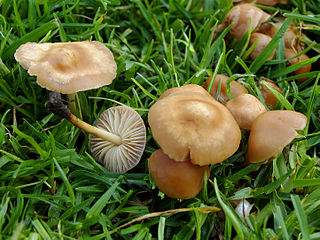
Marasmius oreades, also known as the fairy ring mushroom, fairy ring champignon or Scotch bonnet, is a mushroom native to North America and Europe. Its common names can cause some confusion, as many other mushrooms grow in fairy rings, such as the edible Agaricus campestris and the poisonous Chlorophyllum molybdites.

Collybia is a genus of mushrooms in the family Tricholomataceae. The genus has a widespread but rare distribution in northern temperate areas, and contains three species that grow on the decomposing remains of other mushrooms.

Galerina sulciceps is a dangerously toxic species of fungus in the family Strophariaceae, of the order Agaricales. It is distributed in tropical Indonesia and India, but has reportedly been found fruiting in European greenhouses on occasion. More toxic than the deathcap, G. sulciceps has been shown to contain the toxins alpha- (α-), beta- (β-) and gamma- (γ-) amanitin; a series of poisonings in Indonesia in the 1930s resulted in 14 deaths from the consumption of this species. It has a typical "little brown mushroom" appearance, with few obvious external characteristics to help distinguish it from many other similar nondescript brown species. The fruit bodies of the fungus are tawny to ochre, deepening to reddish-brown at the base of the stem. The gills are well-separated, and there is no ring present on the stem.

Mycetinis is a genus of fungus in the Omphalotaceae family, containing about eight species formerly classified in Marasmius.

Marasmius elegans, commonly known as the velvet parachute, is a species of fungus in the family Marasmiaceae. It has a reddish-brown cap, and a whitish stipe with white hairs at the base. It can be found in eucalypt forests in Australia.

Marasmius rotula is a common species of agaric fungus in the family Marasmiaceae. Widespread in the Northern Hemisphere, it is commonly known variously as the pinwheel mushroom, the pinwheel marasmius, the little wheel, the collared parachute, or the horse hair fungus. The type species of the genus Marasmius, M. rotula was first described scientifically in 1772 by mycologist Giovanni Antonio Scopoli and assigned its current name in 1838 by Elias Fries.
Clavulina delicia is a species of fungus in the family Clavulinaceae. Originally named Clavaria delicia by Miles Joseph Berkeley in 1856, it was transferred to Clavulina in 1950 by British botanist E.J.H. Corner. It occurs in South America.
Roridomyces subglobosus is a species of fungus in the genus Roridomyces, family Mycenaceae.
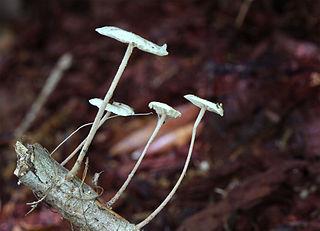
Mycetinis opacus is a species of agaric fungus first described in 1849 by Miles Joseph Berkeley and Moses Ashley Curtis as Marasmius opacus. Andrew Wilson and Dennis Desjardin transferred it to Mycetinis in 2005.

Marasmius siccus, or orange pinwheel, is a small orange mushroom in the Marasmius genus, with a "beach umbrella"-shaped cap. The tough shiny bare stem is pale at the top but reddish brown below, and the gills are whitish. The stem is 3–7 centimetres (1.2–2.8 in) tall and the cap is 0.5–2.5 centimetres (0.20–0.98 in) wide.
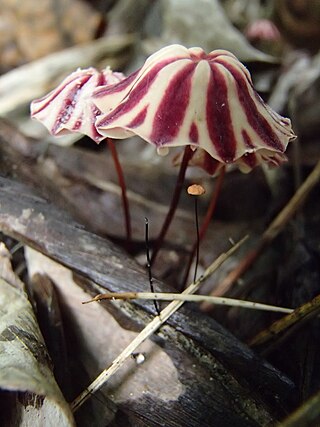
Marasmius tageticolor is a species of agaric fungus in the family Marasmiaceae. Its fruit bodies have striped red and white caps. It is found in Mexico, Central America, and South America, where it grows on twigs.
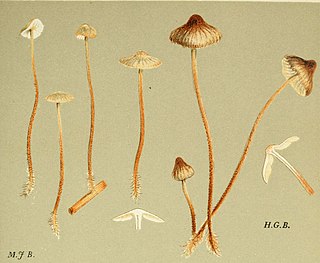
Rhizomarasmius undatus is a small mushroom which grows on fern rhizomes.
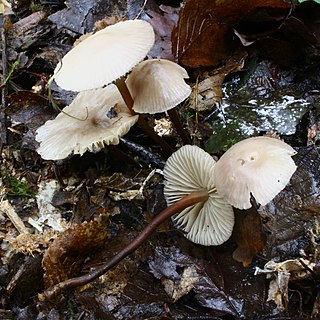
Marasmius wynneae is a species of gilled mushroom found in European woods.















